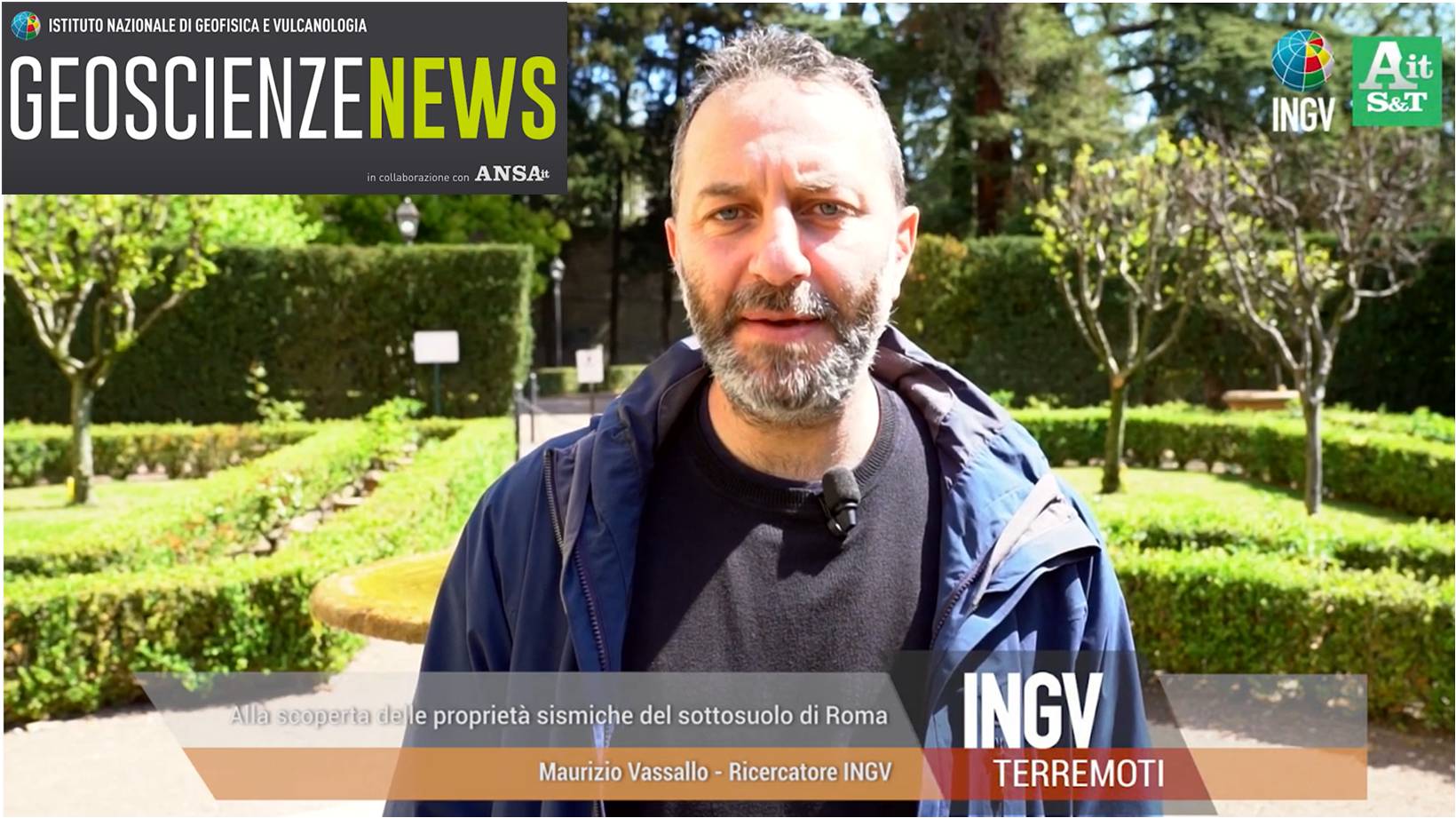
Alla scoperta delle proprietà sismiche del sottosuolo di Roma - TGweb GEOSCIENZE News (14 aprile 2021)"
"Discovering the seismic properties of the subsoil of Rome - TGweb GEOSCIENZE News (April 14, 2021) "
link al documento di approfondimento:
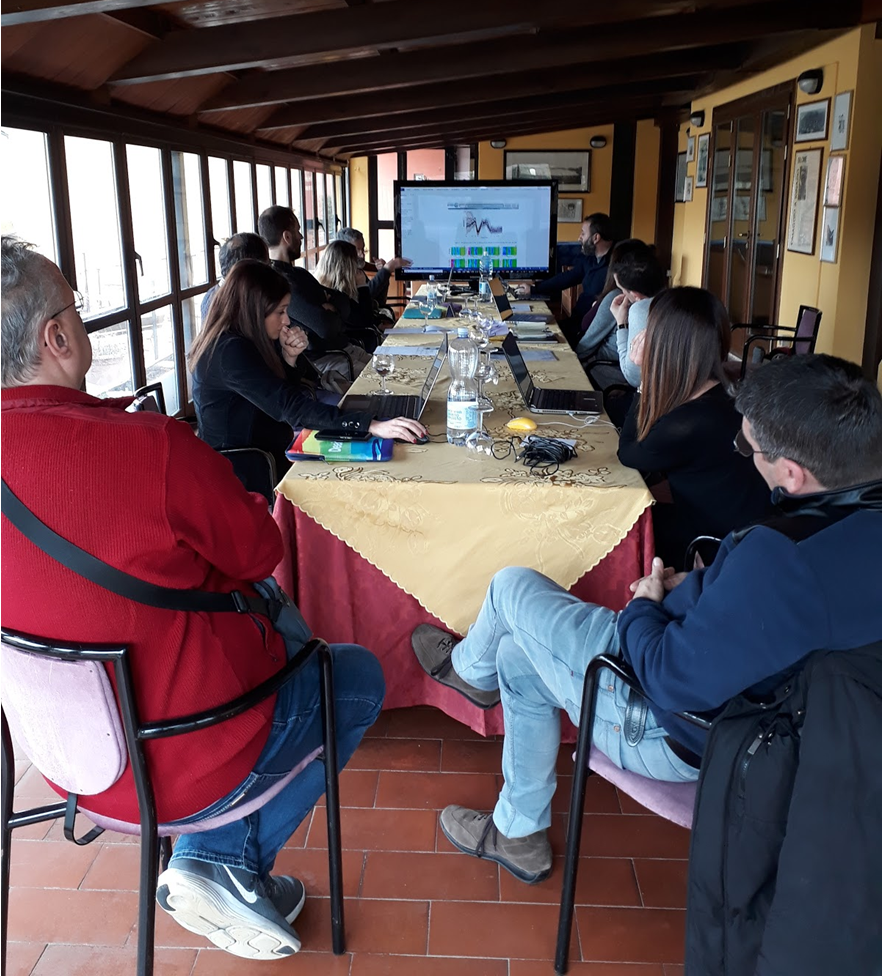 Afferenti al Laboratorio ESITO durante una riunione organizzativa (Avezzano, 21/02/2018)
Afferenti al Laboratorio ESITO durante una riunione organizzativa (Avezzano, 21/02/2018)Personnel of the ESITO Laboratory during an internal meeting (Avezzano, 21/02/2018)
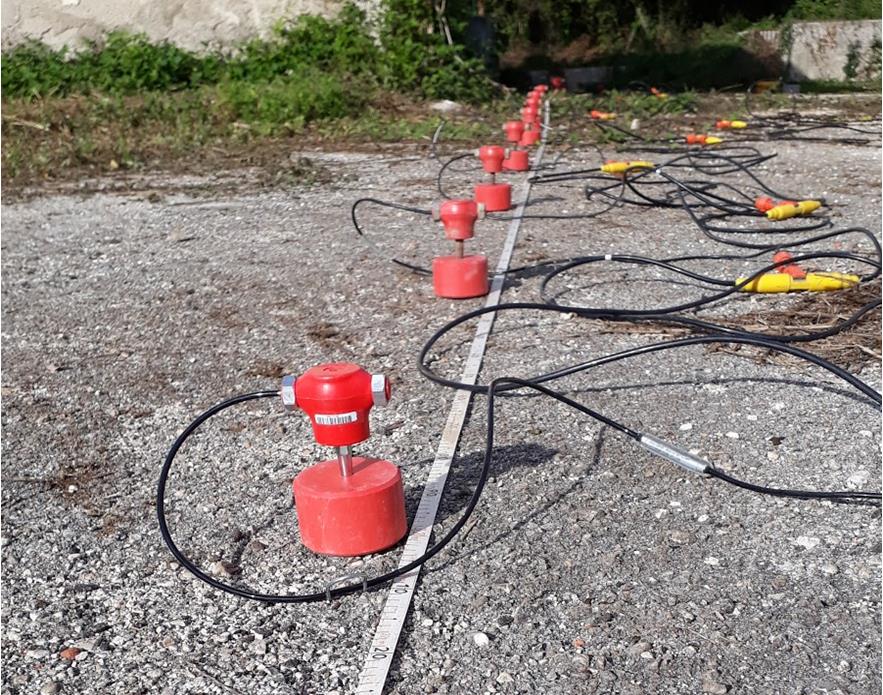 Array lineare di geofoni verticali per Multichannel Analysis of Surface Waves (MASW; Atina 24/10/2019)
Array lineare di geofoni verticali per Multichannel Analysis of Surface Waves (MASW; Atina 24/10/2019)Linear Array of vertical geophones for Multichannel Analysis of Surface Waves (MASW; Atina 24/10/2019)
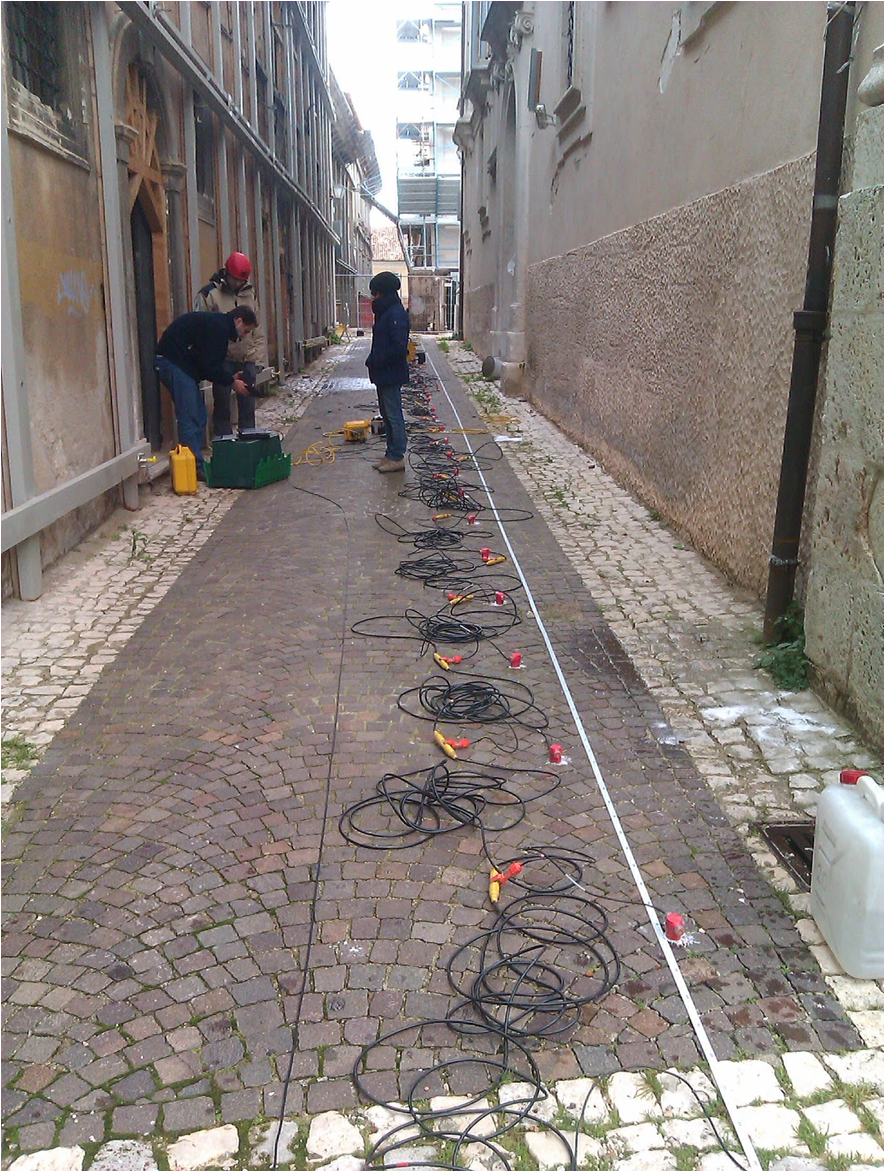 Array lineare di geofoni verticali per Multichannel Analysis of Surface Waves (L’Aquila 05/12/2012 )
Array lineare di geofoni verticali per Multichannel Analysis of Surface Waves (L’Aquila 05/12/2012 )Linear Array of vertical geophones for Multichannel Analysis of Surface Waves ( L’Aquila 05/12/2012)
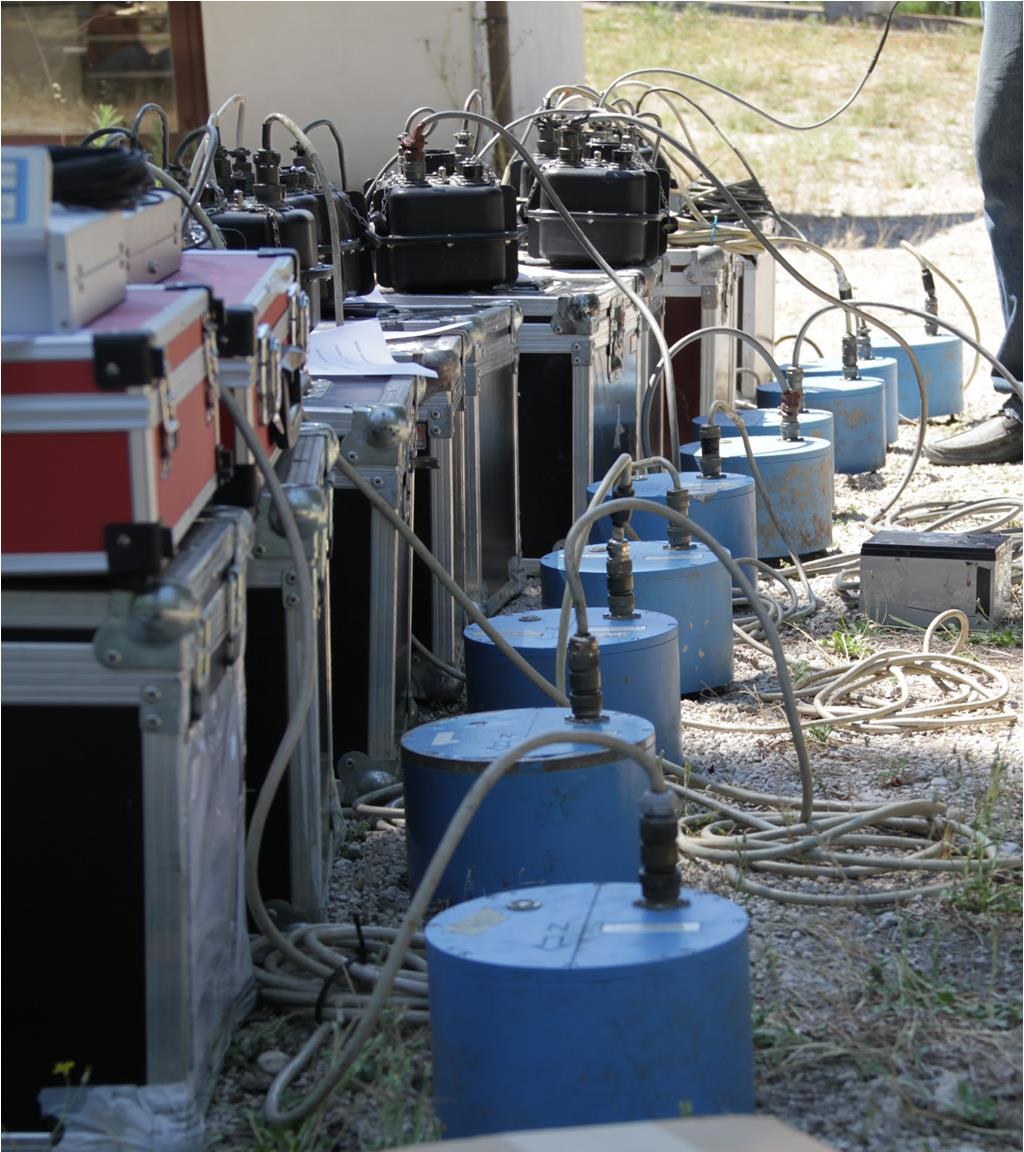 Stazioni sismiche (velocimetri e acquisitori MarsLite e Reftek130) durante un test di verifica del funzionamento (huddle test)
Stazioni sismiche (velocimetri e acquisitori MarsLite e Reftek130) durante un test di verifica del funzionamento (huddle test)Seismic stations (velocimeters, accelerometers and MarsLite e Reftek130 digitizers) during an huddle test of the equipment of the laboratory
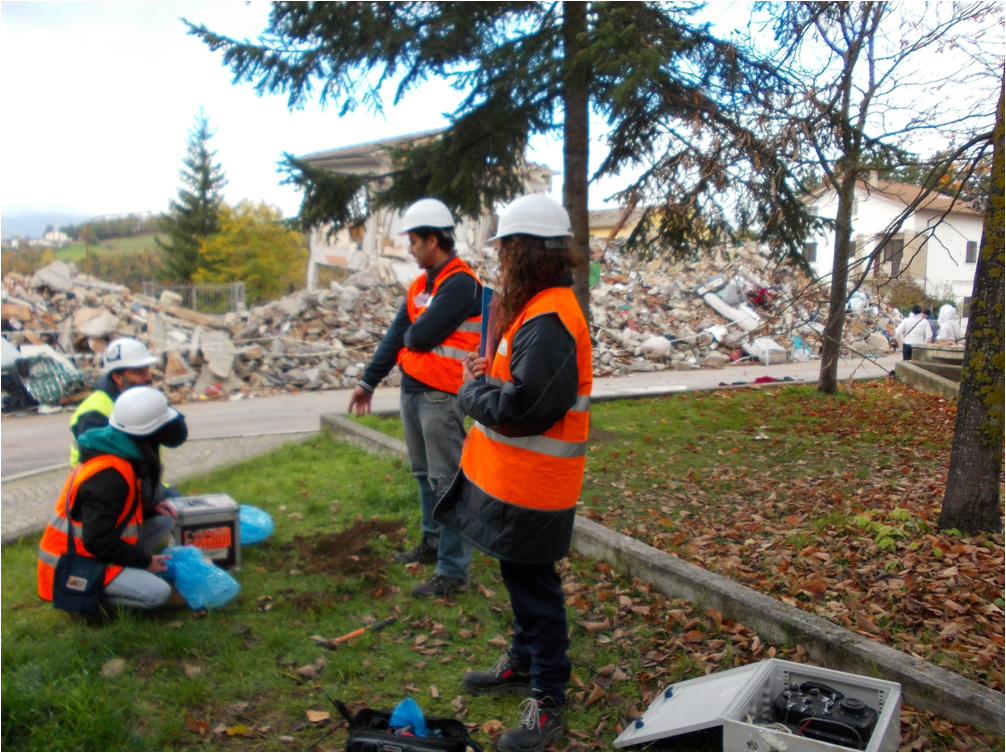
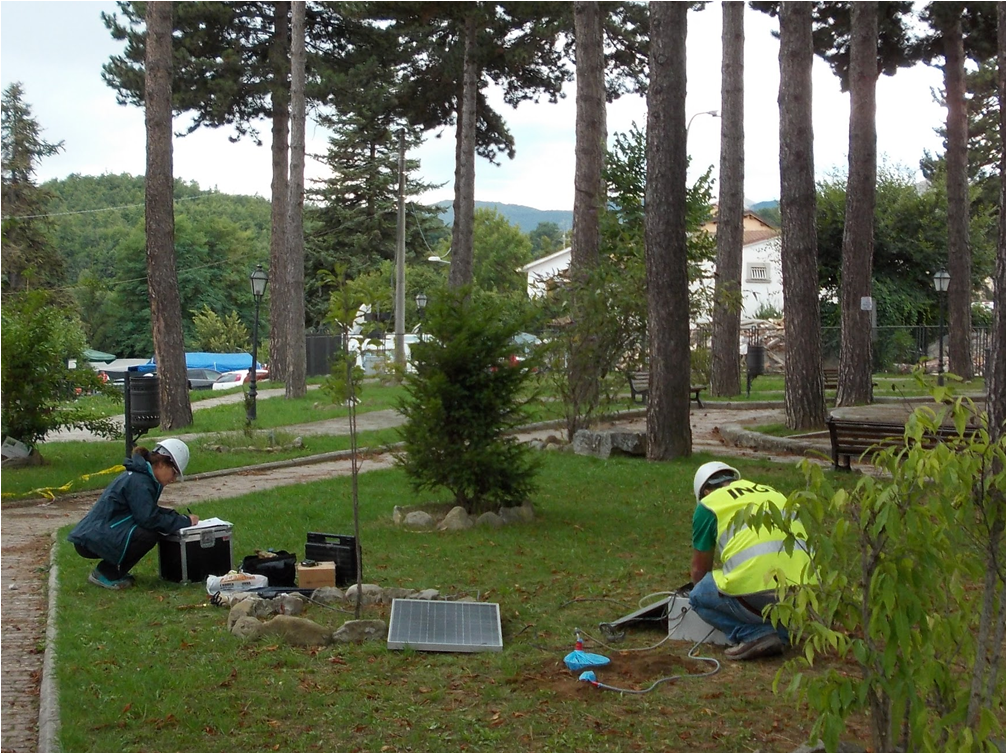 Installazione di stazioni sismiche ad Amatrice, dopo il terremoto Mw 6.0 del 24/08/2016 (settembre 2016)
Installazione di stazioni sismiche ad Amatrice, dopo il terremoto Mw 6.0 del 24/08/2016 (settembre 2016)Installation of seismic stations at Amatrice (network 3A), after the Mw 6.0 earthquake of Central Italy of 24/08/2016 (september 2016)
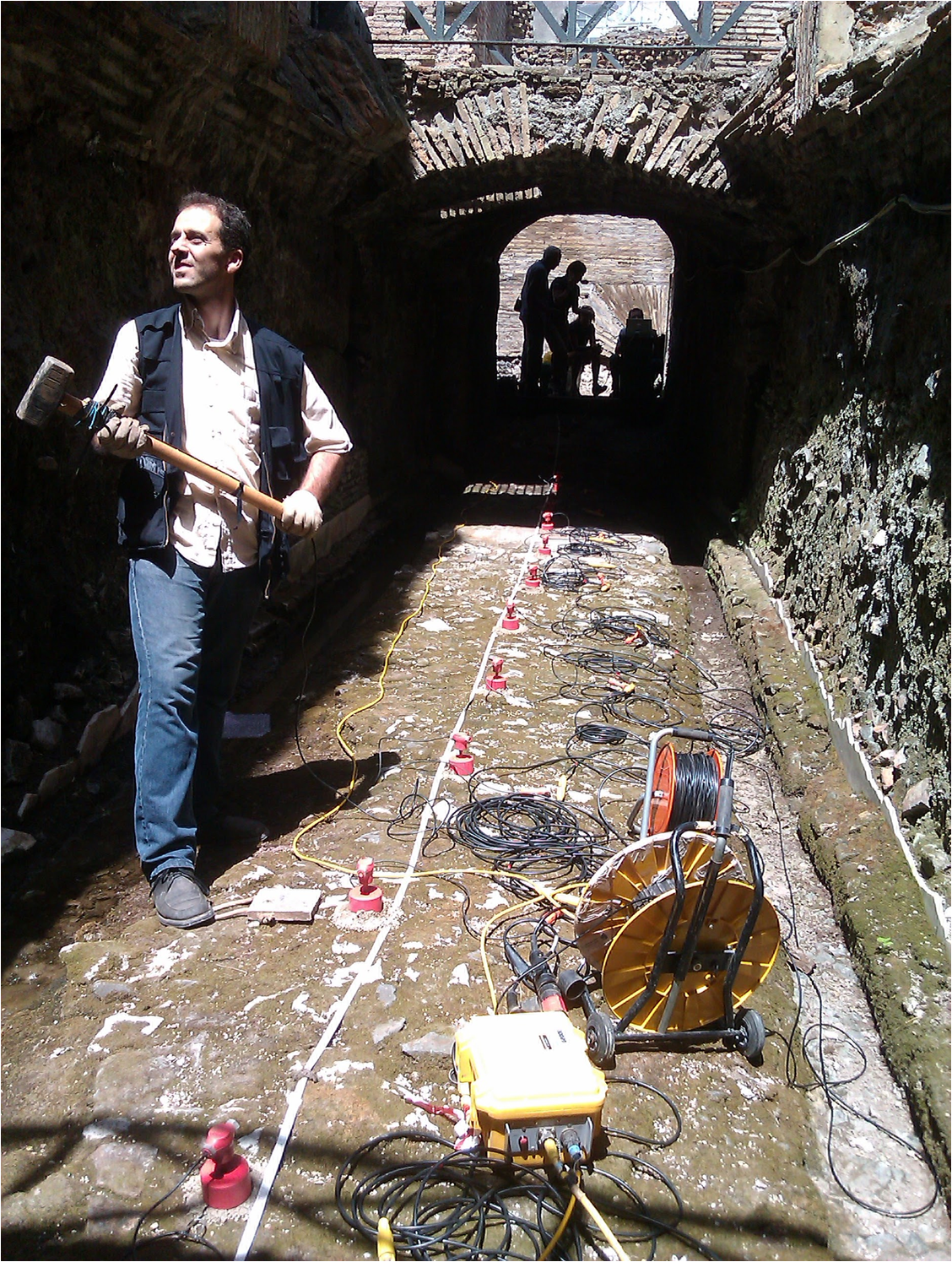 Campagna di sismica attiva nel “Passaggio di Commodo”, Colosseo, Roma, 24/06/2014
Campagna di sismica attiva nel “Passaggio di Commodo”, Colosseo, Roma, 24/06/2014 Active seismic survey in the “Passaggio di Commodo”, Colosseum, Rome, 24/06/2014
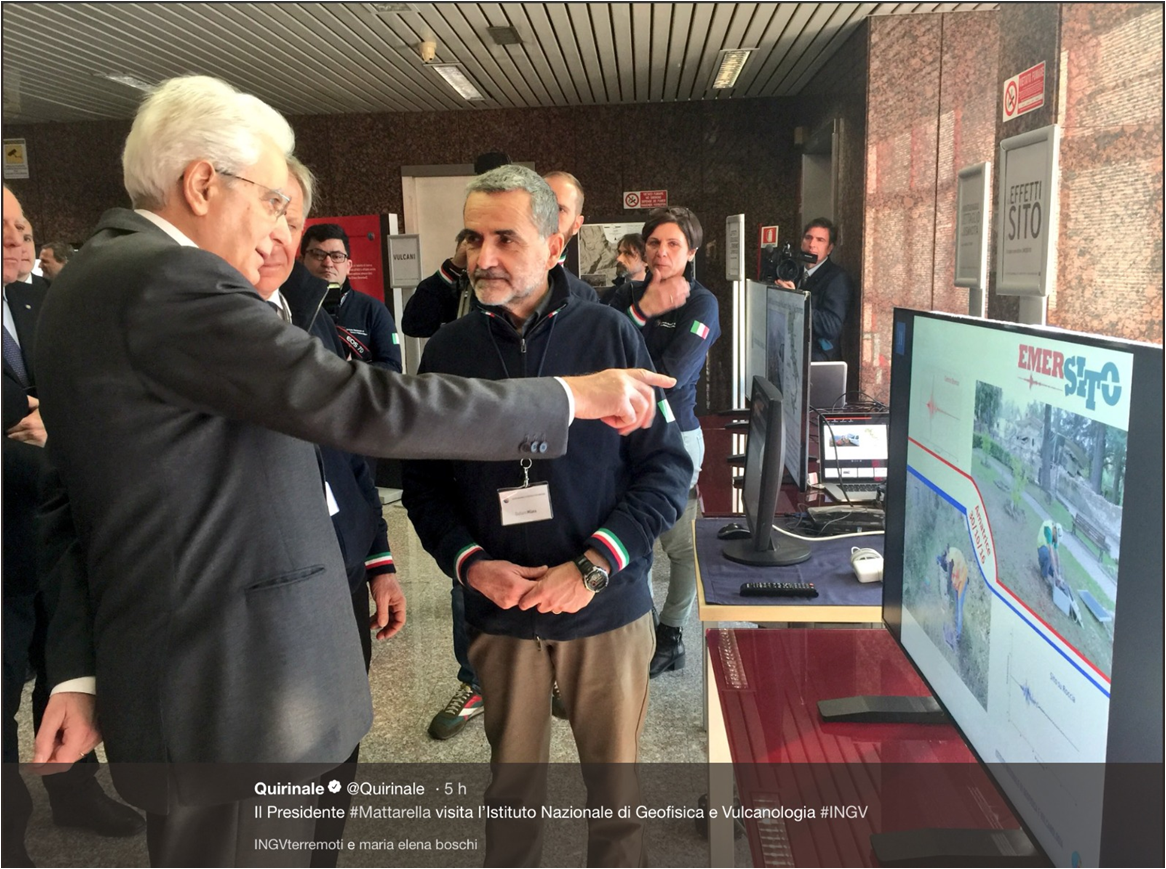 Attività di divulgazione (visita del Presidente della Repubblica, 24/01/2018)
Attività di divulgazione (visita del Presidente della Repubblica, 24/01/2018)Open day at INGV. Showing the activity of the team to the President of the Italian Republic Sergio Mattarella, 24/01/2018.
Il Laboratorio per lo studio degli effetti di sito ESITO fa parte delle infrastrutture della Sezione di Roma 1 dell’INGV ed è dotato di strumentazione utilizzabile nell’ambito di progetti e di proposte di ricerca, tesi di laurea e di dottorato, attività di servizio riguardanti i seguenti campi di attività:
● esperimenti specifici di risposta sismica locale e di caratterizzazione sismica di sito, inclusi siti suscettibili a fenomeni di liquefazione e movimenti franosi
● studi di Microzonazione Sismica (attività propedeutiche e di formazione)
● emergenze sismiche nell’ambito dei gruppi di emergenza
● partecipazione ad esperimenti specifici per progetti nazionali e internazionali o per attività di servizio
● attività divulgative (third mission)
Il Laboratorio ESITO è diviso in tre unità ubicate nelle sedi di Roma, Grottaminarda e L’Aquila. Il Laboratorio assicura il mantenimento e il corretto funzionamento della strumentazione sismica ubicata nelle tre unità, e testa anche nuova strumentazione e pacchetti di analisi, sperimentando sistemi avanzati di acquisizione dati in campagna. L’accesso e l’uso della strumentazione viene regolato dal seguente regolamento
("Regolamento Laboratorio Effetti di SITO Modulo Richiesta prestito").
ESITO is a laboratory devoted to the study of site effects, and it is one of the infrastructures of the Istituto Nazionale di Geofisica e Vulcanologia (INGV, ROMA1 Section). The laboratory employs seismic instruments that are used in national and international projects and research studies, thesis and emergency activities. In the following the main areas of investigation supported by the ESITO laboratory:
● Specific experiments for the study of local seismic response or seismic site characterization, including sites prone to liquefaction or instability phenomena
● Studies related to Seismic Microzonation
● Seismic emergency (in cooperation with the EMERSITO INGV-emergency group)
● Field experiments within national and international projects
● Participation to workshops and meetings dedicated to public and schools (third mission)
The ESITO laboratory is organized in three units based in the INGV offices of Roma, Grottaminarda and L’Aquila. The laboratory ensures the maintenance and the proper operation of the seismic instruments, and also the testing of new instruments and softwares, including advanced data analysis and acquisition systems in the field surveys. The access and the use of the laboratory equipment is regulated by means of a registered document
(Regulation of ESITO, in Italian , Loan Form) .
Effetti di sito
Site Effects
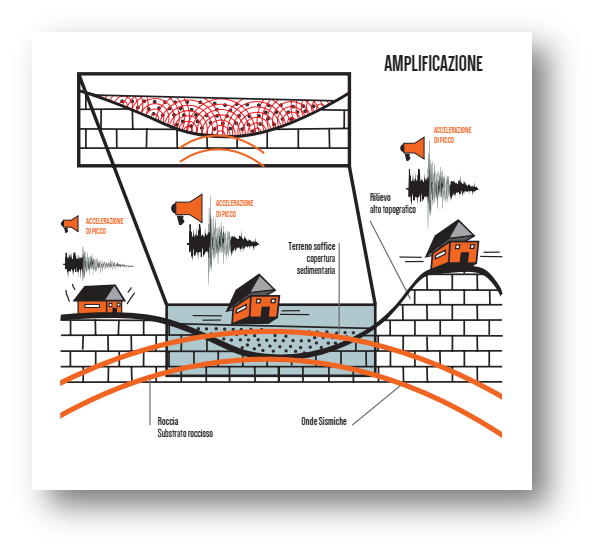
Immagine tratta da “Guida per gli animatori” della Mostra “Attenti agli Elementi. Dettagli che salvano la vita”
Picture redrawn from “Guida per gli animatori” of the event “Attenti agli Elementi. Dettagli che salvano la vita”
Lo scuotimento del terreno è fortemente influenzato, oltre che dalla sorgente del terremoto e dal percorso di propagazione, anche dalle condizioni geologiche, geomorfologiche e geotecniche che le onde sismiche incontrano attraversando gli ultimi strati di terreno prima di arrivare in superficie. Il moto sismico può subire delle notevoli modifiche in termini di ampiezza, contenuto in frequenza e durata dello scuotimento. Tutte queste variazioni vengono indicate come effetti di sito.
Per esempio, gli effetti di sito causati dalla presenza di formazioni geologiche poco compatte (alluvioni, depositi sedimentari, ecc.) su formazioni più rigide, si traducono in un’amplificazione delle onde sismiche in alcuni intervalli di frequenza, che è tanto più grande quanto maggiore è il contrasto di proprietà meccaniche tra i diversi strati. Questo tipo di fenomeno è anche noto come amplificazione stratigrafica. Fenomeni di aggravio del moto sismico possono essere anche prodotti da onde superficiali che si propagano all’interno di bacini o dalla presenza di irregolarità topografiche.
Un altro fenomeno rilevante tra gli effetti di sito è quello causato dal comportamento non-lineare dei terreni, fino ad arrivare alla liquefazione, che può avvenire al passaggio dell’onda sismica nei terreni dove è presente un livello sabbioso saturo d’acqua e a piccole profondità.
Il laboratorio ESITO è un'infrastruttura dell’INGV con strumentazione e personale impegnato nello studio degli effetti di sito; la loro valutazione e conoscenza è fondamentale per la mitigazione degli effetti dell'azione sismica sul costruito e sull’ambiente.
The ground motion during earthquakes is strongly dependent on the seismic source and travel path of the seismic waves. The geological, geomorphological and geotechnical properties related to the uppermost near-surface layers are also important in modifying the seismograms recorded by seismic stations. The ground shaking in presence of site effects can be largely amplified with respect to a reference site, in terms of spectral contents, amplitude levels and motion duration. Such magnification phenomena are generally known as site effects.
For example, site effects are mostly observed in presence of soft deposits characterized by low velocities (alluvial, sedimentary deposits, soft clay, etc..) overlaying stiffer layers: the magnification effect is generally larger when the impedance contrast increases between soft and stiff layers (stratigraphic amplification). Site effects can be also related to multiple reflections and surface waves travelling within the basins, or waves scattered from irregular topographies. A further significant typology of site effects during an earthquake is related to the subsoil non-linearity that can provide liquefaction, with water-saturated unconsolidated sediments that reach a soil rigidity nearly to zero.
The ESITO laboratory groups mostly personnel and seismic instrumentation of INGV-ROMA1 that is focused mainly on study on site effects: research activities and case studies are important to a better knowledge of these phenomena, and to mitigate their effects on the environment, cities and infrastructures.
TEAM
Paola Bordoni, Technologist
Fabrizio Cara, Researcher
Rocco Cogliano, Technical Assistant
Giovanna Cultrera, Senior Researcher
Giuseppe Di Giulio, Researcher (Head of the laboratory)
Daniela Famiani, Technologist
Antonio Fodarella, Technical Assistant
Alessia Mercuri, Researcher (Responsible of the unit in Rome)
Giuliano Milana, Senior Technologist
Stefania Pucillo, Technical Assistant
Gaetano Riccio, Technical Assistant (Responsible of the unit in Grottaminarda)
Maurizio Vassallo, Researcher
Marta Pischiutta, Researcher (sez. Roma2)
Luca Minarelli, Researcher
Sara Amoroso (Researcher from University of Chieti-Pescara associated to INGV)
Salomon Hailemikael (Researcher)
PROGETTI DI RICERCA
Contributing projects to the laboratory or supported by the ESITO laboratory.
304 Conv. INGV-DPC (All.A Emergenze WP 9.2);
520 Conv. regione Molise “Microzonazione sismica abitati provincia di Isernia- Collaborazione di ricerca - supporto scientifico”;
542 FIRB-Abruzzo “Indagini ad alta risoluzione per la stima della pericolosità e del rischio sismico nelle aree colpite dal terremoto del 6 aprile 2009”;
865 FISR-2016 “Centro di studio e monitoraggio dei rischi naturali dell'italia centrale”;
972 Conv. INGV-DPC B2 2019-21, WP1 Task 2 “Caratterizzazione siti accelerometrici”;
905 MZS Amatrice “Attività propedeutiche alla microzonazione sismica del Comune di Amatrice”;
906 MZS Casamicciola “Attività propedeutiche alla microzonazione sismica del Comune di Casamicciola Terme (NA);
911 MZS UMBRIA-MARCHE-LAZIO-ABRUZZO ” Microzonazione sismica terzo livello dei comuni colpiti dai sismi del 24 agosto 2016 e del 26 e 30 ottobre 2016”.;
929 EDI-SECUR “Sviluppo di un innovativo sensore ottico per il monitoraggio del comportamento dinamico di edifici in area sismica”;
947 MISE-DGSAIE “Accordo operativo tra MISE DGSAIE e INGV per studi sulla risposta sismica dell'area dell'impianto di spinta di Sulmona”;
963 Microzonazione Avezzano Livello 3 “Convenzione per la realizzazione di indagini geofisiche di supporto alla Microzonazione Sismica di Livello 3 nel Comune di Avezzano (Aq)”;
979 PON-GRINT “European plate observing system GRINT”;
1011 MZS-III ISCHIA “Microzonazione sismica Livello-III Comuni di Casamicciola Terme, Lacco Ameno e Forio”;
FACILITIES
The instrumentation is organized and managed in three units of INGV (Roma, L’Aquila and Grottaminarda) and is actually composed of :
- seismic digitizers (Reftek 130, Lennartz Marslite, Quanterra Q330 e Kinemetrics Etna)
- accelerometers and velocimeters (Kinemetrics Episensor, Lennartz 5s)
- multi-channel system (three Geodes by Geometrics) with vertical and horizontal geophones; set of cables with different spacings, tools (sledge hammer and plates) for active shots to generate P and S waves, minigun source etc.
- system for electric tomography (Syscal R2 equipment managed in cooperation with Roma2 Section)
- other devices and dedicated tools such as batteries, solar panels, gps, tablets, mass storages, etc..
.
ATTIVITÀ (dal 2016)
List of experiments
- Seismic characterization of stations (within activity of DPC_INGV All B2): Campotto Po CMPO-IV, Città di Castello CDCA-IV, Castelnuovo Assisi CSA-IT, Norcia NRCA-IV, Arquata RQT-IT, Montereale MTR-IT, Mascioni MSC-IT, Antrodoco ANT-IT, Roma sede ROM9-IV, Lanuvio LAV9-IV, Ortucchio ORC-IT , Ischia IOCA-IV e CML-IT, TERO-IV, TER-IT, , BIOG-IV, SULP-IT , ATI-IT, SORA-IT, RMMR-IT
- Topographic effects: Amandola, Civitella del Tronto and Montereale (EMERSITO)
- Sites prone to liquefaction: Bondeno (FE) and Mirabello (FE) with blast tests, Avezzano, Bordano (Udine)
- Seismic local response: Bondeno (FE) e Mirabello (FE) for blast test, L’Aquila, Chieti, Sulmona and Arpino
- Temporary network installed during seismic emergency (cooperation with EMERSITO): Network XO of Amandola, Civitella del Tronto e Montereale, Network 3A with 31 stations installed for microzonation activity (EMERSITO)
- Building analysis: Rieti with EdiSECUR Project
- “Complex” site effects: Amatrice
- Reconstruction of buried geological geometry: Castelluccio di Norcia, Norcia, Castelnuovo Assisi, Avezzano , Roma
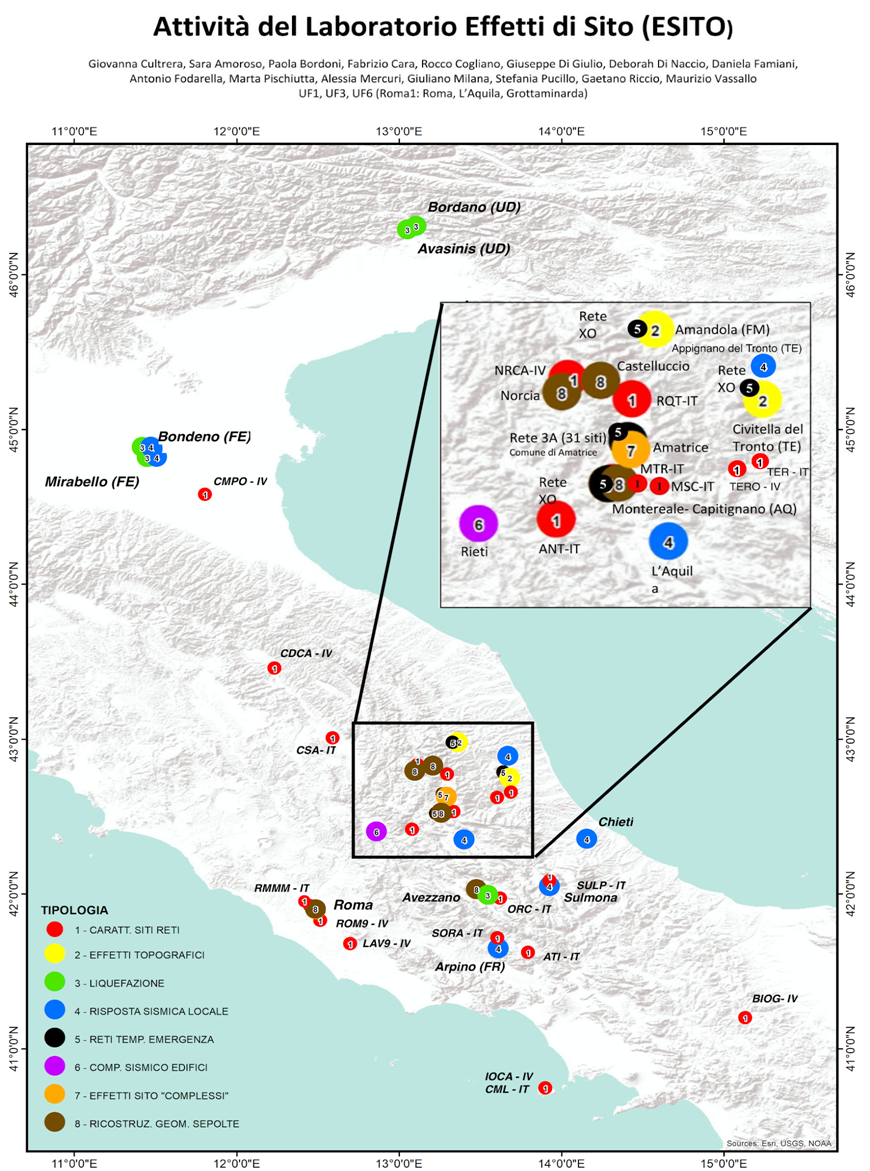
List of peer-reviewed papers (with the support of the laboratory)
2020
- Di Giulio, G., Ercoli, M., Vassallo, M. and Porreca, M., 2020. Investigation of the Norcia basin (Central Italy) through ambient vibration measurements and geological surveys. Engineering Geology, 267, p.105501.
- Famiani, D., Brunori C. A., Pizzimenti L., Cara F., Caciagli M., Melelli L., Mirabella F., Barchi M. R. 2020, Geophysical reconstruction of buried geological features and site effects estimation of the Middle Valle Umbra basin (central Italy) Engineering Geology, 269,, p. 105543
- Di Naccio, D., Famiani, D., Liberi, F., Boncio, P., Cara, F., De Santis, A., Di Giulio, G., Galadini, F., Milana, G., Rosatelli, G., Vassallo M. 2020, Site effects and widespread susceptibility to permanent coseismic deformation in the Avezzano town (Fucino basin, Central Italy): Constraints from detailed geological study, Engineering Geology, 270,, p. 105583
- Rollins, K. M., Amoroso S., Milana, G., Minarelli, L., Vassallo, M., and Di Giulio G. 2020. Gravel Liquefaction Assessment Using the Dynamic Cone Penetration Test Based on Field Performance from the 1976 Friuli Earthquake, Journal of Geotechnical and Geoenvironmental Engineering 146(6),
2019
- Cara, F., Cultrera, G., Riccio, G., Amoroso, S., Bordoni, P., Bucci, A., D’Alema, E., D’Amico, M., Cantore, L., Carannante, S. and Cogliano, R., 2019. Temporary dense seismic network during the 2016 Central Italy seismic emergency for microzonation studies. Scientific data, 6(1), pp.1-15.
- Milana, G., Cultrera, G., Bordoni, P., Bucci, A., Cara, F., Cogliano, R., Di Giulio, G., Di Naccio, D., Famiani, D., Fodarella, A. and Mercuri, A., 2019. Local site effects estimation at Amatrice (Central Italy) through seismological methods. Bulletin of Earthquake Engineering, pp.1-27.
- Priolo, E., Pacor, F., Spallarossa, D., Milana, G., Laurenzano, G., Romano, M.A., Felicetta, C., Hailemikael, S., Cara, F., Di Giulio, G. and Ferretti, G., 2019. Seismological analyses of the seismic microzonation of 138 municipalities damaged by the 2016–2017 seismic sequence in Central Italy. Bulletin of Earthquake Engineering, pp.1-41.
- Marcucci, S., Milana, G., Hailemikael, S., Carlucci, G., Cara, F., Di Giulio, G. and Vassallo, M., 2019. The deep bedrock in Rome, Italy: a new constraint based on passive seismic data analysis. Pure and Applied Geophysics, 176(6), pp.2395-2410.
- Vassallo, M., De Matteis, R., Bobbio, A., Di Giulio, G., Adinolfi, G.M., Cantore, L., Cogliano, R., Fodarella, A., Maresca, R., Pucillo, S. and Riccio, G., 2019. Seismic noise cross-correlation in the urban area of Benevento city (Southern Italy). Geophysical Journal International, 217(3), pp.1524-1542.
2018
- Amoroso, S., Gaudiosi, I., Tallini, M., Di Giulio, G. and Milana, G., 2018. 2D site response analysis of a cultural heritage: the case study of the site of Santa Maria di Collemaggio Basilica (L’Aquila, Italy). Bulletin of Earthquake Engineering, 16(10), pp.4443-4466.
- Boncio, P., Amoroso, S., Vessia, G., Francescone, M., Nardone, M., Monaco, P., Famiani, D., Di Naccio, D., Mercuri, A., Manuel, M.R. and Galadini, F., 2018. Evaluation of liquefaction potential in an intermountain Quaternary lacustrine basin (Fucino basin, central Italy). Bulletin of Earthquake Engineering, 16(1), pp.91-111.
- Theodoulidis, N., Cultrera, G., Cornou, C., Bard, P.Y., Boxberger, T., Di Giulio, G., Imtiaz, A., Kementzetzidou, D., Makra, K. and Argostoli NERA Team, 2018. Basin effects on ground motion: the case of a high-resolution experiment in Cephalonia (Greece). Bulletin of Earthquake Engineering, 16(2), pp.529-560.
2017
- Durante, F., Di Giulio, G., Tallini, M., Milana, G. and Macerola, L., 2017. A multidisciplinary approach to the seismic characterization of a mountain top (Monteluco, central Italy). Physics and Chemistry of the Earth, Parts A/B/C, 98, pp.119-135.
- Riccio, G., Cogliano, R., Di Giulio, G., Fodarella, A., Pucillo, S. and Rovelli, A., 2017. A study of building vibrations induced by weak motions: effects of earthquake excitation, ambient noise and wind speed. Annals of Geophysics, 10.4401/ag-7149
- Di Naccio, D., Vassallo, M., Di Giulio, G., Amoroso, S., Cantore, L., Hailemikael, S., Falcucci, E., Gori, S. and Milana, G., 2017. Seismic amplification in a fractured rock site. The case study of San Gregorio (L'Aquila, Italy). Physics and Chemistry of the Earth, Parts A/B/C, 98, pp.90-106.
- Pischiutta, M., Villani, F., D'Amico, S., Vassallo, M., Cara, F., Di Naccio, D., Farrugia, D., Di Giulio, G., Amoroso, S., Cantore, L. and Mercuri, A., 2017. Results from shallow geophysical investigations in the northwestern sector of the island of Malta. Physics and Chemistry of the Earth, Parts A/B/C, 98, pp.41-48.
- Hailemikael, S., Milana, G., Cara, F., Vassallo, M., Pischiutta, M., Amoroso, S., Bordoni, P., Cantore, L., Di Giulio, G., Di Naccio, D. and Famiani, D., 2017. Sub-surface characterization of the Anphiteatrum Flavium Area (Rome, Italy) through single-station ambient vibration measurements. Annals of Geophysics, 60(4), p.0438.
- Amoroso S., Milana G., Rollins, K. M., Comina, C., Minarelli L. et al., 2017. The first Italian blast‐induced liquefaction test (Mirabello, Emilia‐Romagna, Italy): Description of the experiment and preliminary results. Annals of Geophysics, 60(5):S0556, https://doi.org/10.4401/ag-7415
2016
- Cultrera, G., D'Alema, E., Amoroso, S., Angioni, B., Bordoni, P., Cantore, L., Cara, F., Caserta, A., Cogliano, R., D'Amico, M. and Di Giulio, G., 2016. Site effect studies following the 2016 Mw 6.0 Amatrice earthquake (Italy): the Emersito Task Force activities. Annals of Geophysics, 59.
- Di Giulio, G., de Nardis, R., Boncio, P., Milana, G., Rosatelli, G., Stoppa, F. and Lavecchia, G., 2016. Seismic response of a deep continental basin including velocity inversion: the Sulmona intramontane basin (Central Apennines, Italy). Geophysical Journal International, 204(1), pp.418-439.
Miscellanea (International Meeting and Report)
- Milana, G., Cultrera G., Cogliano R., Pucillo S., Riccio G., 2019. Velocity profile report at the seismic stations IT.ATI – Atina (FR), http://hdl.handle.net/2122/12970
- Famiani, D., Cultrera, G., Cara, F., Di Giulio, G., Milana, G., Todrani, A., Vassallo, M., Amoroso, S., Bordoni, P., Cogliano, R. and Di Naccio, D., 2019. Site effects estimation and their effects on strong ground motion at Amatrice village (Central Italy). In AGU Fall Meeting 2019.
- Cultrera G., Bordoni P., Casale P., Cara F., Di Giulio G., Famiani D., Ladina C., Pischiutta M., Quintiliani M., Pacor F. and Site Characterization Team (2018). Site characterization database of INGV Italian seismic network. S34 - Developments in Strong Motion Seismology, a COSMOS Session. ESC-S34-872. The European Seismological Commission ESC2018 36th General Assembly, 2-7 Sept. 2018, La Valletta, Malta.
- Vassallo, M., Milana G., Di Giulio G., Bordoni P., Cogliano R., Fodarella A., Pucillo S., Riccio G., 2018, Velocity profile report at the seismic stations IV.IOCA and IT.CML - Casamicciola Terme, Ischia, doi: 10.5281/zenodo.2281844, doi: 10.5281/zenodo.2281845
- Bordoni P., F. Pacor, P. Casale, G. Cultrera, F. Cara, G. Di Giulio, D. Famiani, C. Ladina, M. Pischiutta, M. Quintiliani, and the Site Character Team (2017). Site characterization of the national seismic network of Italy. European Geosciences Union (EGU) General Assembly, Vienna, Austria, April 2017. In EGU 2017 General Assembly Abstracts (Vol. 19, p. 18604).
- Cultrera, G., Famiani, D., Milana, G., Amoroso, S., Angioni, B., Bordoni, P., Cara, F., Cogliano, R., D'Amico, M., Di Giulio, G. and Di Naccio, D., 2017. Gruppo operativo EMERSITO-evento sismico ISCHIA 2017: Rapporto n. 1 23/08/2017.
Dissemination
- Participation to the exhibition “Attenti agli elementi! Dettagli che salvano la vita”, Grottaminarda (AV), 22 November2019 - 31 January 2020,
- Scientific partner in the framework of the Ruritage project (Heritage for Rural Regeneration https://www.ruritage.eu/project/, Horizon 2020). A pair of seismic stations (in borehole and at surface) was installed in the municipality hub of Appignano del Tronto, (AP, Italy), 13-14 November 2019, http://www.adriaticonews.it/2019/11/15/appignano-del-tronto-citta-resiliente-si-lavora-allaction-plan/
- Training Course Ordine dei Geologi del Lazio, “Tecniche non invasive a supporto degli studi di risposta sismica locale”, Roma, Sala INGV, 16-5-2019
- Meeting with the school “ Istituto Geometri Colecchi-Da Vinci L’Aquila”, Seminario Microzonazione sismica, 22 Febbrary 2019, http://www.ilcapoluogo.it/2019/03/07/microzonazione-sismica-ricostruzione-e-pianificazione-territoriale-allistituto-per-i-geometri/
- Open Day INGV - “Terremoti tra memoria e prevenzione”, INGV, 20 January 2019
- Pint of Science L'Aquila 2018, Cafè Garibaldi “La sismologia dei bidoni: da un esperimento a piccola scala alla microzonazione sismica”, 14 May 2018 https://pintofscience.it/event/la-sismologia-dei-bidoni-da-un-esperimento-a-piccola-scala-alla-microzonazione-sismica
- INGV initiative "Insieme per convivere con i terremoti" ad Amatrice (29/10/2017)
- “Porte aperte all'INGV: a un anno dalla sequenza sismica Amatrice-Visso-Norcia”, INGV of Rome (24/08/2017)
- Participation to “European Researchers' Night ” in L’Aquila within SHARPER project (EU Project within Marie Skłodowska-Curie Horizon 2020 - GA 722981): 25/09/2015, 30/09/2016, 29/09/2017, 28/9/2018, 27/9/2019


